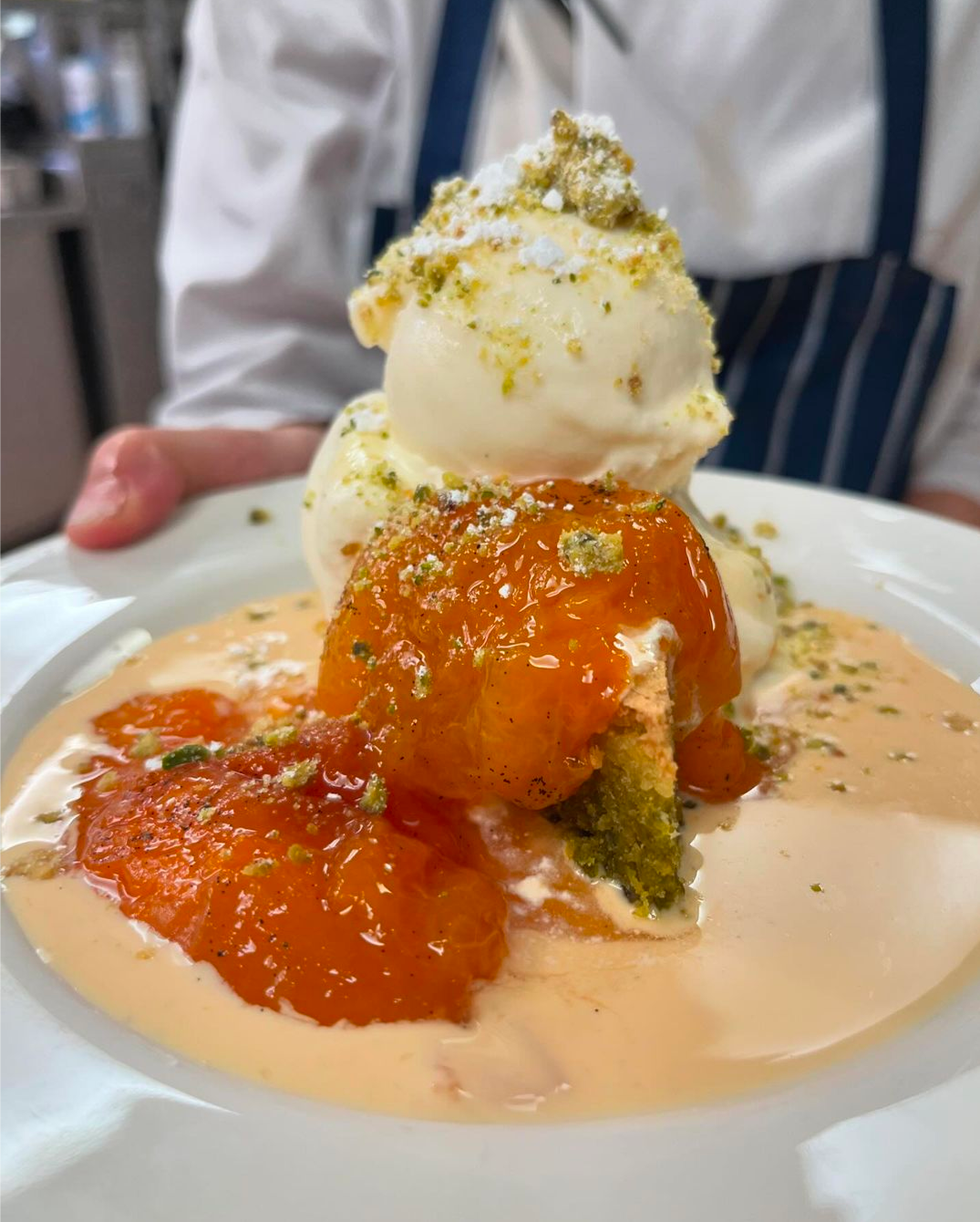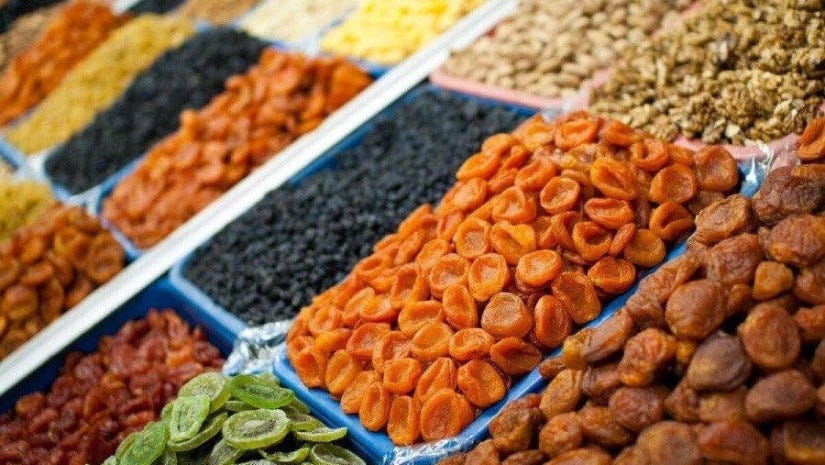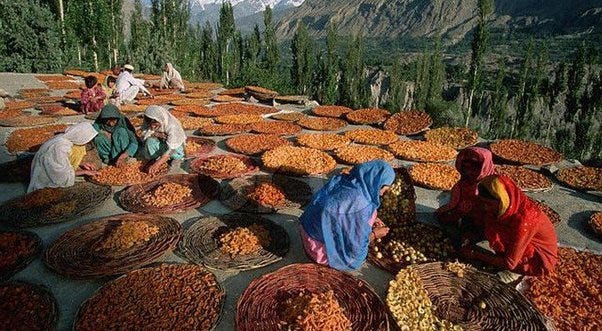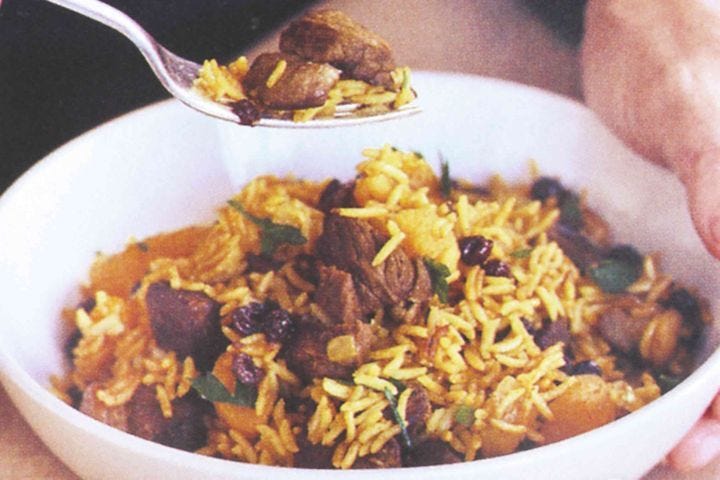
I tell lies about what I eat. I say, “I don’t eat puddings, I’m more of a salty person”. Not true. Yes, I eat salt. I also eat sweet. I eat everything greedily, except stewed pears which I will dispatch with politeness but without relish. When I was a PR in publishing, my favourite author was the one who ignored the free-loading male sales reps around the post-book-signing restaurant table all saying “No thanks” when the pudding trolley was wheeled up. He took in my expression and announced to the waiter, “I’d like some of everything on your biggest plate, please, with 8 spoons.” Did the reps tuck in? Guess.
After a majestic couple of courses at London’s Quo Vadis, I spotted this on the menu.
It’s a pistachio cake, green, in a puddle of scented cream and cloaked in a fudge-like, chunky apricot puree, under a ball of ice cream. Along with the extra crunch of crushed pistachios, there was quite possibly more cream involved.
There are those who can’t abide an apricot. My own struggle with them is working out whether I want home-made apricot jam on my warm, brittle-crusted baguette with cold unsalted butter, or to fit into my shrinking bathing costume.
I’m about to make an apricot liqueur I might be giving you a bottle of at Christmas. I will put 16 or so large ripe apricots into a pan with 1 litre/4½ cups of dry white wine and bring it to the boil, then add 500g/2 cups sugar, ½ litre/2¾ cups vodka or brandy, a stick of proper Sri Lankan, not Chinese, cinnamon or 1½ teaspoons ground cinnamon, and immediately turn off the heat. The liquid gets poured into a warmed china mixing bowl, covered with plastic film and left to infuse for 4 days before being strained into a jug then bottled.
Alcohol is unlikely to lengthen your life but apricots may well - if you choose your apricots with care. Apricots have 10 times more Vitamin A than other fruits and one of the highest levels of antioxidants. They’re also full of fibre. I would show you a photograph of the dried yet softly toffee-like apricots a friend brought me from that glorious nation of bountiful fruits, Georgia, except I ate them all before I thought about it.
When fresh apricots aren’t in season, I seek out dried Hunza apricots, which you can find in health food shops, Middle East markets, or online. Small and somewhat gnarly, Hunzas are a whole different fruit from regular, more buxom dried apricots, of which 21 percent of the world’s annual 3.9 million tonnes are grown in Turkey. But Hunzas are more intensively apricot-y, with a hint of peach, and more spicy, and more fruity, and more scented.
These fruits the size of a walnut and just as wizened grow in the wild, but are also cultivated in orchards from the Hunza valley to Iran. Hunza is a remote state high in the mountains of Kashmir, a nominally self-governing region administered by Pakistan whose inhabitants have been known to live for as long as 140 years. Their longevity is probably as much to do with the fact their organic diet is predominantly vegetarian, their produce watered by pure glacier melt, and their need to climb like agile goats up and down mountains to get anywhere, as it is to do with their consumption of apricots.
Intensely sweet, you should not add sugar when stewing them. Just simmer them in the water you have soaked them in, adding more to cover if necessary, until soft. This will take some time, but will turn them into the buttery, fudgy fruits that will change your view of apricots.
When I was part of a group taken round the Republic of Georgia by the wife of ედუარდ ამბროსის ძე შევარდნაძე, as Eduard Shevardnadze, Gorbachev’s Foreign Minister, is exuberantly knitted, we happened ‘by chance’ upon a wedding feast in a country meadow. In the way of privileged people, we joined the festivities, places suddenly appearing at the long table stretched along a slope of laden vines, found seats between the very extended families of the bride and groom. We were deeply uncomfortable to be the interlopers at such an intimate event - until one of our number reported back from the outdoor lavatory that its walls were still wet from fresh paint, a cement mixer berthed outside next to pile of new bricks.
The table was congested with platters, not only overlapping but piled on top of one another as more and more food was brought out. It’s curious how often at an expansive feast there is one particular dish you eat that stands out. At that wedding, for me it was a vast plate of spiced rice charged with chunks of lamb, onions, raisins, walnuts, the mound coated in a sticky, glossy apricot sauce not unlike that oozing over the slice of pistachio cake (above). Georgians since have told me it is not a local dish of theirs at all, but comes from Iran. Who knows how Mrs Shevardnadze had briefed her team.
Two weeks ago in the UK, Middle East-originating jars of nuts in syrup were recalled because of fears that the apricot kernels they contained could “release hydrogen cyanide when consumed.” When I included in a recent cookbook a recipe for a French open-faced apricot tart that, in traditional use-everything French fashion, involved cracking open the apricot pits, blanching the kernels and scattering them over the pie before baking, my American publishers made me delete any reference to the stones’ menacing centres and instead propose a sprinkling of almond flakes. You won’t find such squeamishness in any European or Middle East household familiar with this centuries-old tradition. It is true, however, should you be planning to write a crime novel, that amygdalin, a naturally-occurring compound in apricot kernels that converts to cyanide, could make some feel nauseated or far worse. Three small kernels for an adult and half a small kernel for children is as much as the European Food Safety Authority (EFSA) thinks advisable which is no more than 20 micrograms of cyanide per kilogram of body weight at one time. But the French are a plucky people.
The early Arab Abbasid dynasty, centred in Persia (Iran), was keen on meats cooked with fruits, especially the mishmish, the apricot, which emphasises the mild sweetness of lamb. This is as close as I can come to that ‘wedding’ feast’s Lamb Plov - or Polo as it would be in Persian cuisine.
125g/4oz butter plus 2 tablespoons
1 onion finely chopped
500g/1lb lean lamb, cubed
Salt and pepper
½ teaspoon ground cinnamon
¼ teaspoon crushed coriander seeds
2 tablespoons seedless golden raisins (I like the jumbo ones)
125g/4oz dried apricots, preferably Hunza, soaked till softened
500g/1 lb long grain or Basmati rice
Melt 125g/4oz butter in a large saute pan, add the onion and gently stew till soft and golden. Raise the heat, add the lamb and brown the cubes. Season with salt and pepper, add the spices, the raisins and apricots. Fry for a further 2 minutes, stirring well. Pour in water to just cover, set a lid over and simmer 1 ½ hours.
If the stew is too liquid, strain it into another pan, boil hard to reduce then return to the meat.
Boil the rice in water with salt and the tablespoons of butter for 10-15 minutes until not entirely soft. Drain any remaining water then layer the rice and the meat, beginning and ending with the rice, in a heavy pan. Lay a double layer of clean tea-cloth over the top then press down the lid. Set over a low heat and steam for 20 minutes when the cloth will absorb enough of the steam to stop the rice becoming soggy, and the meat sauce will have been absorbed into the rice.






Whenever I think about apricots, I can't help thinking about the huge gnarly apricot tree in the backyard of our cottage in Santa Monica. It probably was planted at the time the house was built, in the 1920s, and was mostly dead. There was one living portion of the tree, and the year we moved in, we pruned and watered and fed the tree with plant fertilizer spikes. We were rewarded the next two years with an abundant harvest of apricots so juicy that when you bit into one, the juice ran down your arm. Their fragrance of was ambrosial. Many fruit trees have a finite life, and orchardists will girdle the trunk in the year before they plan to cut down the tree, which reponds by putting out a final burst of fruit. Our old apricot tree's swan song was the second huge crop, and despite feeding it again, we had no more fruit from it for the rest of the years we lived there. But I remember sprawling in a lounge chair under the tree, reaching up to pluck orb after orb from its branches, gorging on that glorious fruit. Every apricot I have eaten since, even those I've had shipped to me from a California orchard, have been a disappointment.
Spot on! I recently had Georgian food in Bari, Italy. Since then Georgian cuisine keeps pinging my culinary radar.
I first experienced stone fruit with meat and veg in a tagine prepared for me by a French student in Lyon just below the confluence of Les Deux Fleuves...your writing and adventuring makes my heart light and my feet want to wander. I live in ME... Maine that is and have never explored the Middle East but I can see now its either there or Japan.
The birds are calling and the sea awaits🧜🏼♀️